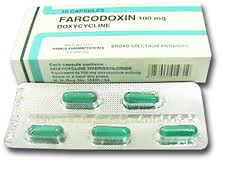
Farcodoxin
Capsules
Broad Spectrum Antibiotic
Composition:
Each capsule contains:
Doxycycline hydrochloride 126.7 mg (equ. to 100 mg doxycycline)
Properties:
Farcodoxin ( doxycycline is a long acting broad spectrum antibiotic with a potent bacteriostatic activity against a wide range of gram – positive and gram – negative bacteria. Farcodoxin is also active against chlamydiae, rickettsiae and mycoplasmas which are insensitive to several antimicrobial agents. Farcodoxin acts on bacterial ribosomes where it binds specifically to 30s ribosomal subunits causing inhibition of protein synthesis. Farcodoxin is more lipophilic with less affinity for some metallic ions than most other tetracyclines.
Pharmacokinetics :
Farcodoxin is almost completely absorbed from the GIT (90 – 100 %) regardless of the presence of food or milk. peak plasma concentrations are achieved within 2 rours and’ about 80 – 95 % of the drug is bound to plasma proteins. the drug is widely distributed into body fluids ( including CSF ) and tissues ( e. g. brain, eye, endometrial, myometrial, prostatic and renal) due to its high lipid solubility. part of the drug is excreted. unchanged in the urine ( 30 – 42 % ) the majority is concentrated in the bile and reaches the intestine where it undergoes enterohepatic circulation and is finally eliminated in the feces mainly as inactive products. The drug therefore has relatively little impact on the intestinal microflora and thus minimizing the incidence of candidal over growth and irritative diarrhea. In patients with renal impairment, increased amounts of Farcodoxin are excreted in the feces and the drug does not accumulate significantly in the serum,hence there is no need for dose adjustment. The plasma half – life of the drug is 18 – 24 hours permitting once or twice administration per day.
Antimicrobiat spectrum :
Farcodoxin is more active than most other tetracyclines against a wide range of aerobic and anaerobic microorganisms including:
Gram – positive bactreria :
Aerobes : streptococcus pyogenes, S. Pneumoniae, S. faecalis, Staphylococcus aureus, bacillus anthracis and listeria monocytogenes. Anaerobes : Propionibacterium acnes, clostridium and peptostreptococcus species.
Gram – negative bacteria:
Aerobes: Neisseria gonorrhoeae, Branhamella catarrhalis, Bartonella bacill- iformis,Calymmatobacterium granulomatis, Campylobacter jejuni, Francisella tularensis,Haemophilus ducreyi, H. Influenzae, Legionella pneumophila, pseudomonas mallei, P. pseudomallei, vibrio cholerae, yersinia pestis, Y. enterocolitica, Escherichia coli and Brucella, Enterobactor, Klebsiella and
Shigella species.
Anaerobes: Bacteroides fragilis and Fusobacterium fusiforme.
Miscellaneous microorganisms:
Rickettsia prowazekii, R.mooseri, R. rickettsii, Coxiella burnetii, Chlamydia trachomatis, C. Pneumoniae, C. psittac, Mycoplasma pneumoniae, Ureaplasma urealyticum, Borrelia recurrentis, B. duttonii, Treponema pallidum, T. Pertenue, Leptospira and Actinomyces species and some protozoa ( Entamoeba histolytica, Balantidium coli, Dientamoeba fragi/is and certain strains of plasmodium falciparum ).
Indications :
Inlections caused by susceptible organisms:
– Respiratory tract infections: severe bronchitis with chronic purulent infections, empyema, pneumonia, atypical pneumonia, bronchiectasis, lung abscess, cystic fibrosis, acute respiratory infections with chronic lung disease ( e.g. Bronchitis and chronic obstructive pulmonary disease such as emphysema) and mixed respiratory tract infections.
– Ear, nose and throat infections: otitis media, slnushis and ulcerative
pharyngitis.
– Eye infections: trachoma, inclusion conjunctivitis and other ophtalmic infections.
– Genlto • urinary tract Infections: pyelonephritis, cystitis, urethritis, cervicitis, epididymo • orchitis, chronic prostatitis and other pelvic infections.
– Venereal diseases: lymphogranuloma venereum, chancroid, granuloma inguinale, gonorrhea and syphilis.
– Gastrointestinal tract infections: cholecystitis, cholangitis, enteritis, traveller’s diarrhea, balantidiasis, dientamoebiasis, acute intestinal amoebiasis ( as an adjunct therapy), bacillary dysentery and cholera.
– skin, soft tissue and bone Infections: acne, cellulitis, abscesses, frunculosis, pyoderma, infected traumatic and post- operative wounds and yaws.
– Mouth and teeth Infections: ulcerative gingivostomatitis, periodontal abscess and following dental manipulations.
– Other infections: brucellosis, relapsing fever, leptospirosis, typhus, rocky mountain spotted fever, Q fever, psittacosis, anthrax tularemia, plague, listeriosis, bartonellosis, Lyme disease ( stage I ) and malaria due to plasmodium falciparum resisant to the antimalarial durgs ( prophylaxis ).
Contralndlcatlons :
Hypersensitivity to tetracyciines.
SIDE EFFECTS :
Farcodoxin is well tolerated and sate. Photosensitivity, allergic reactions
and GIT disturbances, e.g. Nausea, vomiting or diarrhea,might occur.
PRECAUTIONS :
As with the other tetracyclines, doxycycline should not be used during pregnancy, lactation and for children under the age of 8 years
Durg Interactions :
Doxycycline potentiates the effect of oral anticoagulants. The drug interferes with the bactericidal activity of penicillins. Absorption of doxycycline may be impaired by antacids, oral iron preparations, bismuth salts and cimetidine. Barbiturates, carbamazepine and phenytoin decrease the half • life of doxycycline.
Dosage:
Farcodoxln capsules must be swallowed with a full glass of water.
Adults: 1 capsule at 12 hours intervals for one day followed by 1 capsule every 24 hours. In severe infections, 1 capsule every 12 hours for as long as indicated. by the physician.
For prophylaxis of malaria:
the above regimen should be started 1 • 2 days the before entering the malarious areas and continued for 4 weeks after leaving the area.
Acne vulgaris :
1 capsule every other day for 12 weeks.
Packing:
A box containing 10 capsules.
Storage:
Keep at 15 • 30′ C, away from moisture.
Keep out of the reach of children.
produced by :
pharco pharmaceuticals Alexandria
